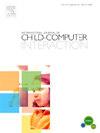Game over? Investigating students’ working memory, situational interest, and behavioral patterns as predictors of dropout in an educational game
Q1 Social Sciences
International Journal of Child-Computer Interaction
Pub Date : 2025-01-08
DOI:10.1016/j.ijcci.2025.100721
引用次数: 0
Abstract
Educational games are designed to increase students' motivation and persistence. Nevertheless, student dropout is a very common issue that many game interventions in education face, which can hamper students' learning opportunities. Dropout can be manifested in different ways for different reasons, for instance quitting due to lack of interest or failing due to lack of abilities to succeed in the game. Thus far, little is known about the underlying factors that lead to student dropout. The present paper (N = 272 early secondary school students) investigates different types of dropout and whether students' working memory capacity and situational interest are predictive of the likelihood of dropping out during an educational game using augmented reality (AR). Moreover, log data were used to explore differences in students' in-game behavior (i.e., number, type, and patterns of mistakes) while playing the game. The results indicate that 16.9% of the students dropped out during the game, either because they quit or because they failed to reach the last level. Working memory capacity and situational interest were not predictive of students' dropout. However, process maps of students’ in-game behavior showed that dropout students differed in the number of mistakes they made and also followed a different behavioral pattern than non-dropout students. In all, this study contributes to the knowledge base by revealing different types of dropout students who showed distinct behavioral patterns. More insights into these patterns could help to identify students at-risk of dropping out early on and to develop targeted interventions to prevent dropout.
游戏结束了吗?在教育游戏中调查学生的工作记忆、情境兴趣和行为模式作为辍学的预测因素
教育游戏的设计是为了提高学生的动力和毅力。然而,学生辍学是许多游戏干预教育面临的一个非常普遍的问题,它会阻碍学生的学习机会。由于不同的原因,退出可以以不同的方式表现出来,例如由于缺乏兴趣而退出,或者由于缺乏在游戏中取得成功的能力而失败。到目前为止,人们对导致学生辍学的潜在因素知之甚少。本研究以272名初中生为研究对象,研究了不同类型的辍学行为,以及学生的工作记忆容量和情境兴趣是否对增强现实教育游戏中的辍学行为具有预测作用。此外,使用日志数据来探索学生在玩游戏时的游戏行为差异(即错误的数量、类型和模式)。结果表明,16.9%的学生在游戏过程中退出,要么是因为他们退出,要么是因为他们没有达到最后一级。工作记忆容量和情境兴趣对学生的辍学没有预测作用。然而,学生在游戏中的行为过程图显示,辍学学生犯的错误数量不同,而且他们的行为模式也与非辍学学生不同。总之,本研究通过揭示不同类型的辍学生表现出不同的行为模式,为知识库做出了贡献。对这些模式的深入了解有助于及早发现有辍学风险的学生,并制定有针对性的干预措施来防止辍学。
本文章由计算机程序翻译,如有差异,请以英文原文为准。
求助全文
约1分钟内获得全文
求助全文
来源期刊

International Journal of Child-Computer Interaction
Social Sciences-Education
CiteScore
7.20
自引率
0.00%
发文量
73
 求助内容:
求助内容: 应助结果提醒方式:
应助结果提醒方式:


